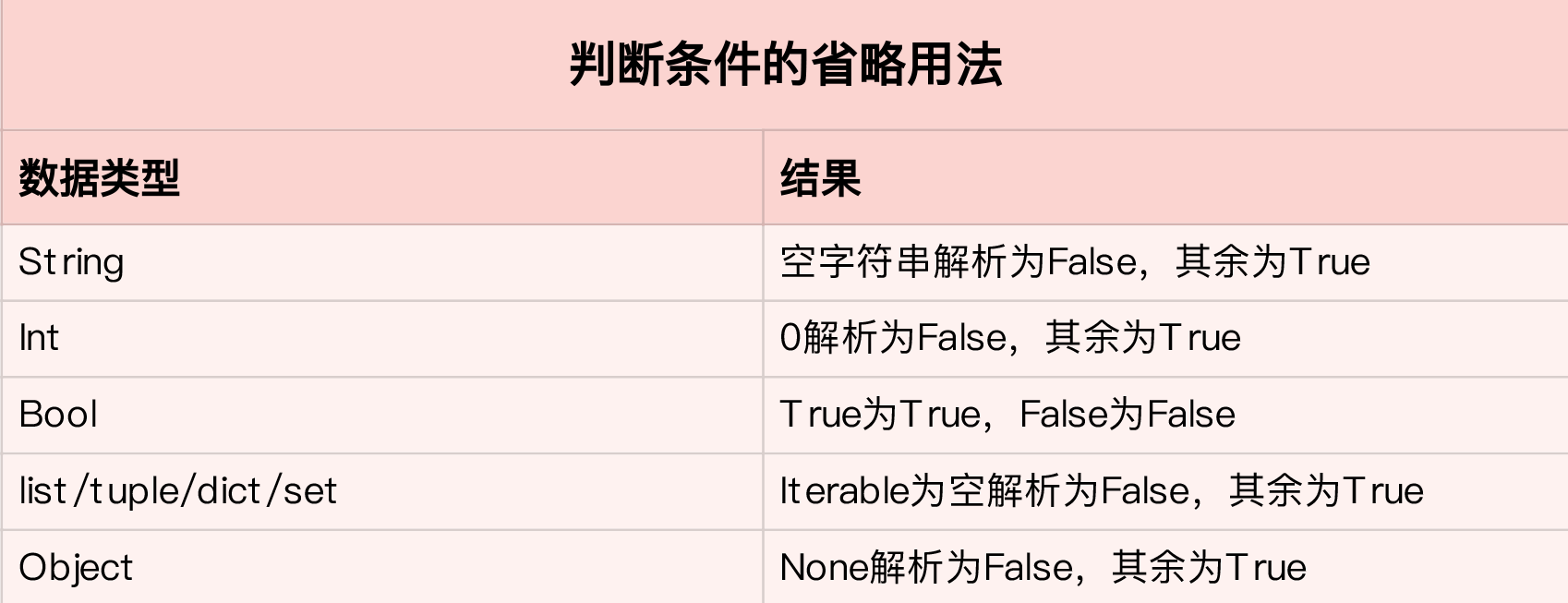07 | 修炼基本功:条件与循环

讲述:冯永吉
时长09:48大小8.98M
你好,我是景霄。
前面几节,我们一起学习了列表、元祖、字典、集合和字符串等一系列 Python 的基本数据类型。但是,如何把这一个个基本的数据结构类型串接起来,组成一手漂亮的代码呢?这就是我们今天所要讨论的“条件与循环”。
我习惯把“条件与循环”,叫做编程中的基本功。为什么称它为基本功呢?因为它控制着代码的逻辑,可以说是程序的中枢系统。如果把写程序比作盖楼房,那么条件与循环就是楼房的根基,其他所有东西都是在此基础上构建而成。
毫不夸张地说,写一手简洁易读的条件与循环代码,对提高程序整体的质量至关重要。
条件语句
首先,我们一起来看一下 Python 的条件语句,用法很简单。比如,我想要表示 y=|x|这个函数,那么相应的代码便是:
和其他语言不一样,我们不能在条件语句中加括号,写成下面这样的格式。
但需要注意的是,在条件语句的末尾必须加上冒号(:),这是 Python 特定的语法规范。
由于 Python 不支持 switch 语句,因此,当存在多个条件判断时,我们需要用 else if 来实现,这在 Python 中的表达是elif。语法如下:
整个条件语句是顺序执行的,如果遇到一个条件满足,比如 condition_i 满足时,在执行完 statement_i 后,便会退出整个 if、elif、else 条件语句,而不会继续向下执行。这个语句在工作中很常用,比如下面的这个例子。
实际工作中,我们经常用 ID 表示一个事物的属性,然后进行条件判断并且输出。比如,在 integrity 的工作中,通常用 0、1、2 分别表示一部电影的色情暴力程度。其中,0 的程度最高,是 red 级别;1 其次,是 yellow 级别;2 代表没有质量问题,属于 green。
如果给定一个 ID,要求输出某部电影的质量评级,则代码如下:
不过要注意,if 语句是可以单独使用的,但 elif、else 都必须和 if 成对使用。
另外,在我们进行条件判断时, 不少人喜欢省略判断的条件,比如写成下面这样:
关于省略判断条件的常见用法,我大概总结了一下:
不过,切记,在实际写代码时,我们鼓励,除了 boolean 类型的数据,条件判断最好是显性的。比如,在判断一个整型数是否为 0 时,我们最好写出判断的条件:
而不是只写出变量名:
循环语句
讲完了条件语句,我们接着来看循环语句。所谓循环,顾名思义,本质上就是遍历集合中的元素。和其他语言一样,Python 中的循环一般通过 for 循环和 while 循环实现。
比如,我们有一个列表,需要遍历列表中的所有元素并打印输出,代码如下:
你看,是不是很简单呢?
其实,Python 中的数据结构只要是可迭代的(iterable),比如列表、集合等等,那么都可以通过下面这种方式遍历:
这里需要单独强调一下字典。字典本身只有键是可迭代的,如果我们要遍历它的值或者是键值对,就需要通过其内置的函数 values() 或者 items() 实现。其中,values() 返回字典的值的集合,items() 返回键值对的集合。
看到这里你也许会问,有没有办法通过集合中的索引来遍历元素呢?当然可以,其实这种情况在实际工作中还是很常见的,甚至很多时候,我们还得根据索引来做一些条件判断。
我们通常通过 range() 这个函数,拿到索引,再去遍历访问集合中的元素。比如下面的代码,遍历一个列表中的元素,当索引小于 5 时,打印输出:
当我们同时需要索引和元素时,还有一种更简洁的方式,那就是通过 Python 内置的函数 enumerate()。用它来遍历集合,不仅返回每个元素,并且还返回其对应的索引,这样一来,上面的例子就可以写成:
在循环语句中,我们还常常搭配 continue 和 break 一起使用。所谓 continue,就是让程序跳过当前这层循环,继续执行下面的循环;而 break 则是指完全跳出所在的整个循环体。在循环中适当加入 continue 和 break,往往能使程序更加简洁、易读。
比如,给定两个字典,分别是产品名称到价格的映射,和产品名称到颜色列表的映射。我们要找出价格小于 1000,并且颜色不是红色的所有产品名称和颜色的组合。如果不用 continue,代码应该是下面这样的:
而加入 continue 后,代码显然清晰了很多:
我们可以看到,按照第一个版本的写法,从开始一直到打印输出符合条件的产品名称和颜色,共有 5 层 for 或者 if 的嵌套;但第二个版本加入了 continue 后,只有 3 层嵌套。
显然,如果代码中出现嵌套里还有嵌套的情况,代码便会变得非常冗余、难读,也不利于后续的调试、修改。因此,我们要尽量避免这种多层嵌套的情况。
前面讲了 for 循环,对于 while 循环,原理也是一样的。它表示当 condition 满足时,一直重复循环内部的操作,直到 condition 不再满足,就跳出循环体。
很多时候,for 循环和 while 循环可以互相转换,比如要遍历一个列表,我们用 while 循环同样可以完成:
那么,两者的使用场景又有什么区别呢?
通常来说,如果你只是遍历一个已知的集合,找出满足条件的元素,并进行相应的操作,那么使用 for 循环更加简洁。但如果你需要在满足某个条件前,不停地重复某些操作,并且没有特定的集合需要去遍历,那么一般则会使用 while 循环。
比如,某个交互式问答系统,用户输入文字,系统会根据内容做出相应的回答。为了实现这个功能,我们一般会使用 while 循环,大致代码如下:
同时需要注意的是,for 循环和 while 循环的效率问题。比如下面的 while 循环:
和等价的 for 循环:
究竟哪个效率高呢?
要知道,range() 函数是直接由 C 语言写的,调用它速度非常快。而 while 循环中的“i += 1”这个操作,得通过 Python 的解释器间接调用底层的 C 语言;并且这个简单的操作,又涉及到了对象的创建和删除(因为 i 是整型,是 immutable,i += 1 相当于 i = new int(i + 1))。所以,显然,for 循环的效率更胜一筹。
条件与循环的复用
前面两部分讲了条件与循环的一些基本操作,接下来,我们重点来看它们的进阶操作,让程序变得更简洁高效。
在阅读代码的时候,你应该常常会发现,有很多将条件与循环并做一行的操作,例如:
将这个表达式分解开来,其实就等同于下面这样的嵌套结构:
而如果没有 else 语句,则需要写成:
举个例子,比如我们要绘制 y = 2*|x| + 5 的函数图像,给定集合 x 的数据点,需要计算出 y 的数据集合,那么只用一行代码,就可以很轻松地解决问题了:
再比如我们在处理文件中的字符串时,常常遇到的一个场景:将文件中逐行读取的一个完整语句,按逗号分割单词,去掉首位的空字符,并过滤掉长度小于等于 3 的单词,最后返回由单词组成的列表。这同样可以简洁地表达成一行:
当然,这样的复用并不仅仅局限于一个循环。比如,给定两个列表 x、y,要求返回 x、y 中所有元素对组成的元祖,相等情况除外。那么,你也可以很容易表示出来:
这样的写法就等价于:
熟练之后,你会发现这种写法非常方便。当然,如果遇到逻辑很复杂的复用,你可能会觉得写成一行难以理解、容易出错。那种情况下,用正常的形式表达,也不失为一种好的规范和选择。
总结
今天这节课,我们一起学习了条件与循环的基本概念、进阶用法以及相应的应用。这里,我重点强调几个易错的地方。
-
在条件语句中,if 可以单独使用,但是 elif 和 else 必须和 if 同时搭配使用;而 If 条件语句的判断,除了 boolean 类型外,其他的最好显示出来。
-
在 for 循环中,如果需要同时访问索引和元素,你可以使用 enumerate() 函数来简化代码。
-
写条件与循环时,合理利用 continue 或者 break 来避免复杂的嵌套,是十分重要的。
-
要注意条件与循环的复用,简单功能往往可以用一行直接完成,极大地提高代码质量与效率。
思考题
最后给你留一个思考题。给定下面两个列表 attributes 和 values,要求针对 values 中每一组子列表 value,输出其和 attributes 中的键对应后的字典,最后返回字典组成的列表。
你能分别用一行和多行条件循环语句,来实现这个功能吗?
欢迎在留言区写下你的答案,还有你今天学习的心得和疑惑,也欢迎你把这篇文章分享给你的同事、朋友。
精选留言(82)
- yshan2019-05-24 33[(xx, yy) for xx in x for yy in y if x != y]
应该是 if xx != yy] 吧
思考题一行:
[dict(zip(attributes,v)) for v in values]展开作者回复: 嗯嗯,笔误已更新。
思考题👍 - AllenGFLiu2019-05-25 14思考题
一行版:
[dict(zip(attributes, value)) for value in values]
循环版:
l = []
for value in values:
d = {}
for i in range(3):
d[attributes[i]] = value[i]
l.append(d)展开 - LiANGZE2019-05-24 12课后的练习题,手机打的,格式可能不好看
print( [{ attributes[i]: value[i] for i in range(len(attributes)) } for value in values]) - Fergus2019-05-26 6# Ask
attributes = ['name', 'dob', 'gender']
values = [['jason', '2000-01-01', 'male'],
['mike', '1999-01-01', 'male'],
['nancy', '2001-02-01', 'female']]
# Answers1
lis = []
for i in values:
print(i)
print(dict(zip(attributes, i)))
print(lis.append(dict(zip(attributes, i))))
# Answers2
[dict(zip(attributes, i)) for i in values]
# Answers3
list(map(lambda x: dict(zip(attributes, x)), values))
# Answers4
lis = []
for i in values:
dic = {}
for n, j in enumerate(i):
dic[attributes[n]] = j
lis.append(dic)
print(lis)
我没有想到用多行条件循环语句实现的方法。先留言,然后看别人怎么做的。展开 - Deed2019-05-24 4[dict(zip(attributes, value)) for value in values]展开
- 武林秀才2019-05-28 3一行的
[dict([(attributes[j],values[i][j]) for j in range(len(attributes))]) for i in range(len(values))]展开 - k8scloud2019-05-26 2attributes = ['name','dob','gender']
values = [['jason','2000-1-01','male'],['mike','1999-01-1','male'],['nancy','201-02-01','female']]
output = []
for v in values:
dst = {}
for k in range(len(v)):
dst[attributes[k]] = v[k]
output.append(dst)
print(output)展开 - 夜下凝月2019-05-25 2Python中没有switch,但是可以用字典来代替。
#不调用函数
level = {0:'red', 1:'yellow', 2:'green'}
try:
level(id)
except:
pass
#需要调用函数
def delete (id):
'''delete the movie that id is 0'''
………
………
………
………
opt = {0:delete, 1:warning, 2:allow}
opt[ id ]( id )展开 - 夏秋冬的春...2019-05-31 1# 多行
output_dist = []
for v in values:
dict_at = {}
for i in range(len(attributes)):
dict_at[attributes[i]] = v[i]
output_dist.append(dict_at)
print(output_dist)
# 一行
print( [{ attributes[i]: value[i] for i in range(len(attributes)) } for value in values])展开 - Geek_d848f...2019-05-29 1#多行
res=[]
for value in values:
if len(attributes)!=len(value):
continue
temp={}
for index,each in enumerate(value):
temp[attributes[index]]=each
res.append(temp)
print(res)
#使用zip
s=[dict(zip(attributes,value)) for value in values if len(attributes)==len(value)] - Wing·三金2019-05-27 1# 多行版本
combined = []
for value in values:
temp_dict = {}
for index, attr in enumerate(attributes):
temp_dict[attr] = value[index]
combined.append(temp_dict)
combined
# 单行版本
[{attr: value[index] for index, attr in enumerate(attributes)} for value in values]展开 - 敏杰2019-05-27 1[dict(map(lambda x, y:(x, y), attributes, value)) for value in values]展开
- taoist2019-05-26 1一行: [dict(zip(attributes, value)) for value in values]
多行:
l = []
for value in values:
d = {}
for i,j in zip(attributes, value):
d[i] = j
l.append(d)展开 - catshitfiv...2019-05-24 1写个长的吧
def get_list_dicts(attribs,vals):
result=[]
for l in values:
temp_dict={}
if len(l)==len(attributes):
for i in range(len(attributes)):
temp_dict[attributes[i]]=l[i]
else:
print('values列表中第{}组内值的个数'
'需与属性列表内的个数保持一致!'.format(values.index(l)+1))
return None
result.append(temp_dict)
return result展开 - 游戏2019-06-07多行:
d_ans = []
for v in values:
d_tmp = {}
for index , k in enumerate(attributes):
d_tmp[k] = v[index]
d_ans.append(d_tmp)
print(d_ans)
一行:
print([dict(zip(attributes, v)) for v in values])展开 - vivien_zh2019-06-07
get_dict={}
get_arr=[]
for index, value in enumerate(values):
for index1,key in enumerate(attributes):
get_dict.update({key:values[index][index1]})
print (get_dict)
get_arr.append(get_dict)
print (get_arr)
输出结果:
{'name': 'jason', 'dob': '2000-01-01', 'gender': 'male'}
{'name': 'mike', 'dob': '1999-01-01', 'gender': 'male'}
{'name': 'nancy', 'dob': '2001-02-01', 'gender': 'female'}
[{'name': 'nancy', 'dob': '2001-02-01', 'gender': 'female'}, {'name': 'nancy', 'dob': '2001-02-01', 'gender': 'female'}, {'name': 'nancy', 'dob': '2001-02-01', 'gender': 'female'}]
老师,问下,是因为get_dict是个指针吗?在内部循环输出单个get_dict都是我想要的结果,为什么get_arr.append后,结果就变成最后一组的值重复三次了呢?展开 - supermouse2019-06-05多行的:
attributes = ['name', 'dob', 'gender']
values = [['jason', '2000-01-01', 'male'],
['mike', '1999-01-01', 'male'],
['nancy', '2001-02-01', 'female']]
out = []
for i in range(0, len(values)):
out.append({})
for j in range(0, len(attributes)):
out[i][attributes[j]] = values[i][j]
print(out)展开 - A0.何文祥2019-06-05和其他语言不一样,我们不能在条件语句中加括号,写成下面这样的格式。
可以,但是不必要,用不能不是很妥。 - 林子里2019-06-03[dict(zip(attributes,values[i])) for i in range(0,len(values))]展开
- 易拉罐2019-06-03# general.
expected_output = []
for v in values:
expected_output.append(dict(zip(attributes, v)))
print(expected_output)
# one line
print([dict(zip(attributes, v)) for v in values])展开

